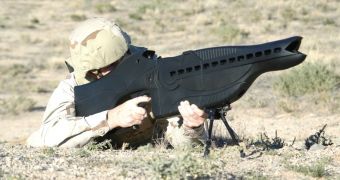It is spelled PHaSR, however I'm more than convinced that the U.S. Department of Defense guys call it phaser. Whether the name is coincidental or not with that of the weapon used in the Star Trek series is not the issue, albeit it closely mimics some of those devices and tactics. They don't call them non-lethal weapons for nothing! The PHASR rifle laser weapon, or the Personnel Halting and Stimulation Response weapon, implies the use of non-lethal laser wavelengths to prevent adversary effectiveness.
PHaSR produces light which, when directed at an aggressor, it illuminates or 'dazzles' him, thus temporarily blinding the enemy without them seeing the source of the laser light. The PHaSR weapon is now coming into testing after blinding laser weapons were previously banned in 1995 by the UN Protocol on Blinding Laser Weapons. The new PHaSR prototype generates a low-intensity laser beam which does not fall into the regulations established by the Blinding Laser Weapons protocol.
The effects of the laser dazzler are only temporary; it operates in two-wavelengths of light and was developed by the Kirtland Air Force Base, which is part of the Air Force Research Laboratory Directed Energy Directorate in New Mexico.
Laser dazzlers are a type of a directed-energy weapon which uses intense beams of light in the visible frequencies of the electromagnetic spectrum. Surprisingly, laser dazzlers have been first used into combat more than 25 years ago by the British forces, during the Falklands War with Argentina, only to be banned in 1995 by the UN. It is extremely efficient at incapacitating enemies for up to a few seconds, however it has the disadvantage that the hostile forces may use optical filters to protect themselves from the effects of such weapons.
A good example would be the photochromic materials, which turn opaque when subjected to intense light, or the non-linear optic solutions which filter the dazzling laser light without even the slightest change in light brightness.

 14 DAY TRIAL //
14 DAY TRIAL //